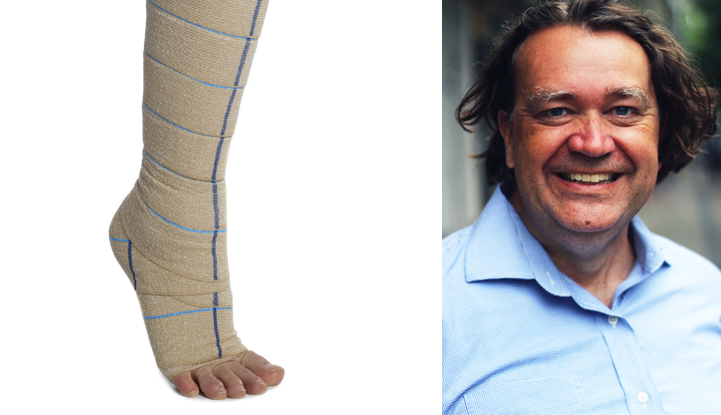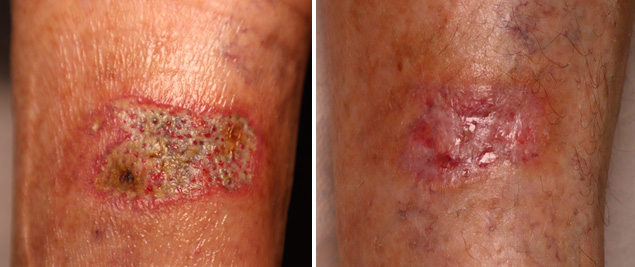Correct pressure with new mathematical method
How hard should you wrap a bandage in order to achieve the correct pressure? Throughout all the years that compression therapy has been used within the medical field, this has been discussed without reaching a consensus. However, more and more signs are indicating that the entire medical compression industry is on its way toward a paradigm shift now that it’s possible to measure pressure in a simple and reliable way. Further, there is a new product today that delivers a predefined pressure based on mathematical modelling.
PressCise is a company that develops medical compression products using innovative, patented textiles developed in partnership with Smart Textiles.
PressCise’s products are used today mostly in relation to healing leg ulcers and oedema; however, to wrap a bandage is – and has always been – very ‘hit or miss’. When everyone uses different compression products and applies them with their own inconstant wrapping technique, the resulting therapy is highly variable and can lead to discomfort, ineffective treatment, injuries, and in the worst case even amputation. The pressure of the bandage depends upon, among other things, the leg’s curvature – how hard and how many turns the bandage is wrapped. PressCise’s bandage has vertical and horizontal lines which show that the applier has wrapped it correctly, and thanks to the unique elastic textile properties, an even pressure can be guaranteed.

Photo: Anna Sigge / Josefina Lundh
As health care generally moves towards increased digitalization, there is also an increased need for compression and pressure gauges to be made more widely available so that both clinics and researchers begin to demand data on pressure readings. More specifically, there are essentially three items on the wish list: 1) A bandage that can give safe and well-defined pressure; 2) a bandage that can sustain the pressure over time; and 3) especially with the coronavirus pandemic in mind, a self-care product that can be applied by a layperson or the patient themselves, from the comfort of their own home. PressCise’s bandage has been designed theoretically to meet the first criterium on the wish list; but as luck should have it, by its very design it automatically fulfills even the other two criteria as well.
Old method makes a developmental leap
“Compression therapy dates back at least 4000 years; however, despite this, bandaging is still applied without the applier knowing what pressure dose is being administered to the patient. There are studies which show that barely 10% of patients are bandaged with the correct pressure dosage. This is now quickly on its way to being changed given that increasingly more pressure sensors are making their way into clinics, and more and more doctors demand precise treatment in the only remaining area of medicine that has not yet been quantified,” says Torbjörn Lundh, professor of biomathematics at both Chalmers University of Technology and the University of Gothenburg.
“We find ourselves in the eye of the storm since we have the only compression product that can give a predetermined pressure. And even further, with a truly smart textile that has been developed beyond the need for electronics,” says Josefin Damm, PressCise’s Chief Technology Officer, as well as an alumnus from the School of Textiles in Borås and a former Smart Textiles employee.
PressCise’s products are also suitable for self-care at home since they are easy to apply – a quality that is coveted in the wake of the pandemic, especially amongst the elderly who are not only at high risk for illness contraction, but also very often having problems with oedema and ulcers. Treatment of leg ulcers alone accounts for as much as 4% of the total cost of healthcare in Sweden. Nearly all of it is due to the cost of personnel skilled in wrapping bandages, which makes self-care highly attractive from an economic perspective as well.

“We have just restarted a clinical study at Southern Älvsborgs Hospital (“SÄS”) in Borås after a pause due to COVID-19, so now we need to recruit patients who suffer from swollen legs or oedema, as it’s called,” explains Ulrika Källman, lead researcher at SÄS.
The study is funded by Vinnova and will evaluate the ability of PressCise’s new compression stocking to reduce leg oedema in comparison to traditional compression stockings. Further, the study will also evaluate the subject’s comfort level, symptom relief and user-friendliness while using the product.
“These types of research studies are a crucial component of being able to evaluate and verify innovative products so that they can therefore benefit healthcare and patients alike. We are very excited about being able to proceed with this study in Borås,” says Josefin Damm.
More patient studies upcoming
In addition to the patient study in Borås, a study of persistent leg ulcers is also underway at the specialist clinic S2Clinic in Linköping, Sweden. Despite the limited size of the studies, treatment with a new type of microtransplant, in combination with PressCise’s controlled compression products, is believed to have the potential to halve the wound healing time while improving cost-effectiveness.
Furthermore, PressCise has a larger planned randomized study at Stanford University Hospital, specifically-developed for venous leg ulcers. This study is currently on hold due to the pandemic, but will hopefully be the key to bringing PressCise’s innovative compression products to a global market.
Read more about PressCise here https://www.presscise.com/
__________________________________________________________________________
Here you can read: “Compression treatment from a patient’s perspective – evaluation of a new innovative compression stocking with well-defined pressure in a randomized controlled study”
